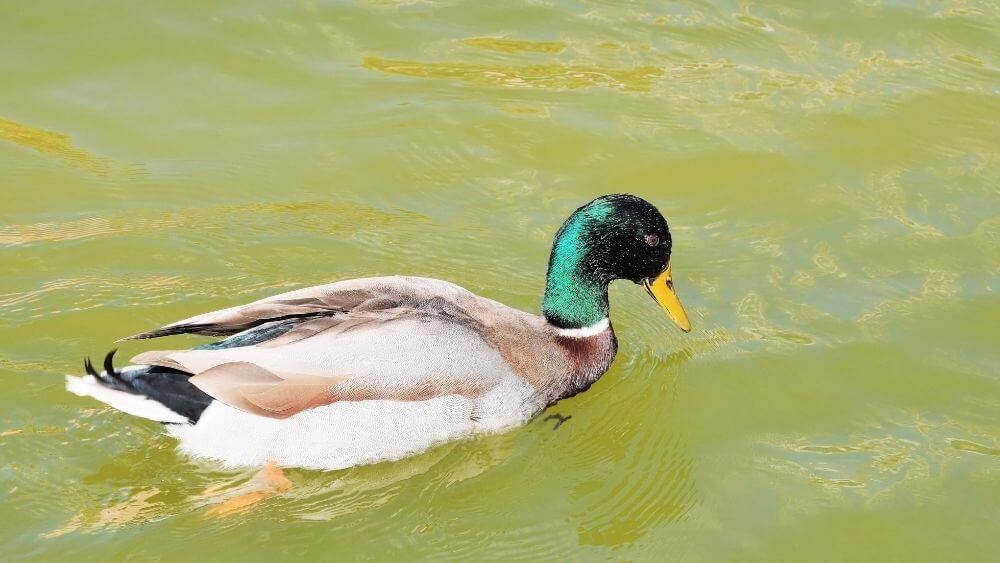Why do ducks float?

Ducks undoubtedly can be considered as the most cutest and adorable inhabitants of the water. They quack away all times, and always move in a group.
Having a life completely within water, it s interesting to know that they can stay afloat and never sink in the water. They move, they feed, they breed and do all other activities by staying in water only, and seldom do they come out offshore.
Lets know how can ducks stay afloat all the times!
Contents
Physical Features
For such a unique ability to stay in water throughout their lives, ducks have developed special physical features in their bodies that aid them to be so.
On a primary note, they have hollow bones and lots of air pockets inside their bodies. These two aspects make them lighter in weight than water and hence it becomes easy for them to float.
Also, they have oily feathers, which keep them waterproof. It shields their beautiful feathery plumages to stay dry and light, and not get soaked in water and become heavy. Having wet feathers make them heavier enough to not float on water, and thus obstruct their regular movement.
Feathers
Alike all species of birds, ducks do also house a fluffy feathery coat. These not just add to its beauty, but also keep them warm in their own skin. The feathers remarkably display an amalgamation of vibrant hues, something that helps to identify the bird quite easily.
The feathers on the duck are able to easily trap air, which enables them to stay afloat. Blank air spaces keeps them light weighted, and hence by exerting very little buoyant force on the surface of water, they remain floating.
Most ducks have three kinds of feathers: flight, contour and down feathers. According to their name, flight feathers assist in flying, contour ones help to resist effect of air when in flight. The down feathers which are usually located near the tail portion of the duck, help hem to keep warm, as well as stay afloat.
Waterproof Body
Well, oily feathers is not completely natural to a duck, and it happens because of a certain physical property of a duck.
A gland near the duck’s tail, known as the Preen Gland produces a kind of oil secretion. The duck then uses this to coat its feathers by using its beak. This technique makes them waterproof enough for water droplets to simply roll off its surface, and that their body do not turn heavy with the added weight of water.
Without such a oily covering, the feathers of the duck would become absolutely soaked in water. And since they spend their whole lives in water, this water-proof body is essential. Beneath this feathery coat are present fluffy and soft feathers which keep the duck warm.
Movement
A duck showcases two different kinds of movement, designated for their stay on land and water respectively.
On the surface of the water, ducks move forward by kicking their webbed feet. This motion is known as paddling. Designed primarily for such a movement, the legs are placed slightly backwards on the body of the duck.
This unique placement, along with their large webbed feet gives the ducks their natural waddle when they walk on land.
The Beak
Similar to all species of birds, the mouth portion of a duck is called a beak. The edge of the beak is soft, and it is used by the duck to feel the food, much like a fingertip in a human being.
Similar to other water-birds, the beak of a duck also has a sharp part at its end. Apart from eating food, ducks use their beaks to spread the oil over their entire bodies to make them waterproof.
Light Bones
All flying birds, including water-birds such as ducks, have hollow bones that make them lightweight. This helps the ducks stay afloat. Hollow bones unlike those with blood and marrow reduce considerably the total weight of the duck, and thus its dual benefits are reaped by the duck in both flying and staying afloat in water.
Air Spaces
Ducks house air sacs inside them as well as amidst their feathers, which make the ducks lighter and help them float. The have a lot of cavities (empty spaces filled with air) in their bodies. Apart from their hollow bones, they have large lungs. In all, ducks have a weight much lesser than their volume, and hence when on water they have minimal buoyant force exertion on the water.
And so they can easily stay afloat.
Fun Facts
- Some sea ducks can dive 200 ft (60 m) underwater, while most ducks can only dive 6 ft (2 m).
- The Sea Otter has the densest fur coat of any animal, which traps a lot of warm air, helping it stay afloat. It can even sleep while floating on its back.
Related Questions:
- How do fishes swim in the water?
- Can ducks survive on land as well?
- How do sea animals breathe while on water?
Objective Questions:
- All flying birds and water-birds have _______ bones.
- _________ helps duck to eat as well.
- ________ feet helps ducks to swim and stay afloat on water.
- Ducks have _______ skin.
- The movement of ducks on water is called ________.
True Or False:
- Ducks have oily feathers: _________
- Most sea-birds are heavy in weight: ______
- Air pockets help trap air and make ducks stay afloat: ________
- Ducks have wide feet: _______
- Most ducks cannot stay in deep water: ________






Responses